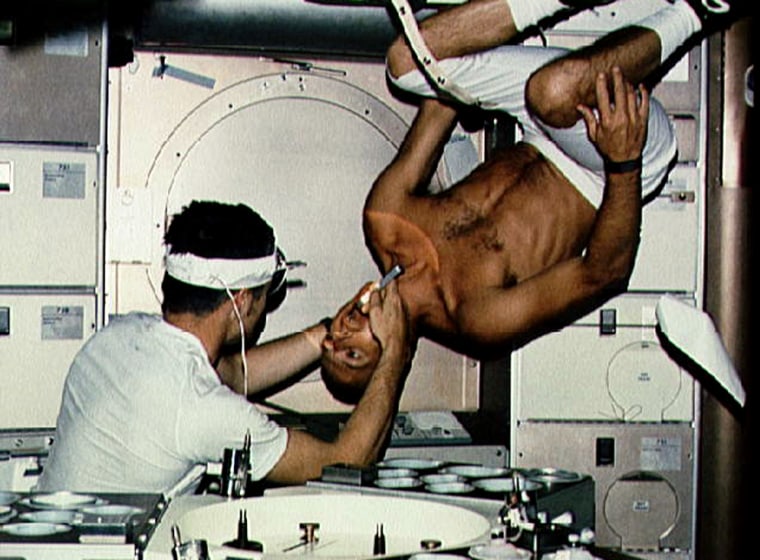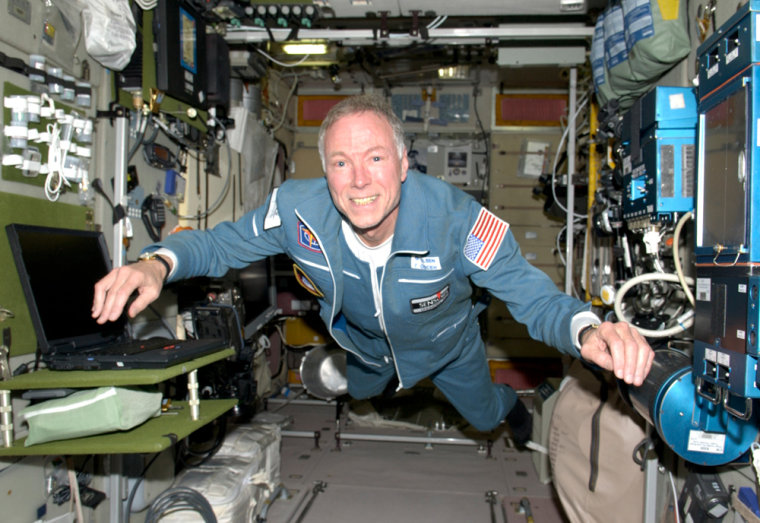In a pioneering gesture of outer space openness, millionaire space traveler Gregory Olsen has officially released his entire space-related medical records for scientific and public scrutiny.
The motivation, his associates say, is to allow detailed study of the specific effects of space flight conditions on one particular individual, so as to advance the science of space medicine in the face of the dual daunting challenges of human flight beyond low Earth orbit and a much wider population of future space travelers.
The release also points out the relative lack of such data available to the public about the professional astronauts and cosmonauts who have flown in space. While extensive records exist, issues of privacy and doctor-patient confidentiality have kept them sealed — even decades after the fact.
Olsen, a 61-year-old New Jersey scientist and businessman, blasted off aboard a Russian Soyuz spacecraft last October for a weeklong visit to the international space station. The trip was arranged for an unspecified price through the Virginia-based Space Adventures, which has arranged trips to space for other private individuals as well.
Olsen's trip was actually delayed for a year for medical reasons that at the time were not released. Widespread speculation at the time centered on heart or lung problems. When he finally did fly, some rumors further suggested that his presence aboard the Soyuz and the space station had elevated the risks of spaceflight and even imposed a medical burden on the professional astronauts and cosmonauts he flew with.
The records released show these rumors to be groundless. The yearlong delay was actually due to concern over possible lung cancer, not over any issues with Olsen's lung function or his cardiovascular system.
“Right before the state medical commission review, a CT scan found a new spot on a lung,” a member of Olsen's medical staff explained by telephone, requesting that his name not be used even though Olsen had granted blanket permission for the interview. Per doctor recommendations, the tissue was biopsied, and Olsen was put under an observation program of about six months to see what would happen to the spot. “It went away spontaneously,” the source reported.
Olsen’s medical team continued to monitor his health status rigorously. “His evaluation pre-flight was exhaustive and unprecedented,” the source team said. “He went to exhaustive efforts to prove he was safe to fly.”
For example, Olsen had once had a collapsed lung, which was discovered only by accident. But as part of flight preparation, he underwent a procedure called bilateral pleurodesis that is analogous to gluing the lungs to his chest cavity so as to prevent any recurrence of collapse. As a result, “the chance for pneumothorax was extremely remote,” the source explained, and “any pneumothorax would have likely been very small or partial.”
Olsen’s lung function was tested at oxygen levels that simulated an elevation of 18,000 feet. “His pulmonary function qualified him as a civil aviation passenger jet pilot,” the source stated, adding that Olsen was tested on a 8 g-force centrifuge ride, more than U.S. and Russian space crews are trained on.
“Dr. Olsen sees the value of the knowledge that can be gained from his space flight for those who follow him,” said Dr. Richard Jennings, his flight surgeon for the mission. “It’s a great gift — you cannot overestimate the importance of this.”
More such candor needed
But the value of Olsen’s medical disclosure goes far beyond answering questions about one single spaceman out of more than 400 people who have flown into orbit. It may serve to encourage other veteran space travelers to also share hitherto unavailable medical information which could be critical to planning for future human space missions.
It’s true that as a result of 45 years of human space flight, extensive medical records and flight data exist for professional astronauts and cosmonauts. But issues of privacy and doctor-patient confidentiality have prevented public identification of individuals associated with specific medical issues.
Space medicine experts do have one valuable resource: NASA’s “Longitudinal Study of Astronaut Health,” a 2004 database of space medical effects, where statistical information is available to researchers after identifying markers are removed.
Yet it is widely believed within the space medicine community that a significant amount of potentially useful information remains off limits, and sometimes not even recorded anywhere. This body of data, potentially important for future more difficult space voyages, involves astronaut and cosmonaut maladies that were treated "off the books," often by private doctors, to avoid official notice that might have grounded the space fliers.
“Suffice it to say, we have had some very close calls,” a veteran astronaut e-mailed privately.
Sometimes it’s a case of medical overreaction leading to self-defensive concealment. After German astronaut Ulf Merbold was medically suspended for a time due to his having had kidney stones when he was 19 (he returned to flight status and made three orbital trips without trouble), at least one astronaut with a major kidney stone history sought private treatment for it lest the NASA doctors learn of it and remove him from a late-1980s shuttle mission.

In such cases, astronauts are following a long-established tradition among pilots of all types to tell their official doctors as little as possible. Many astronauts are themselves doctors, and persistent stories tell of astronaut-physicians being consulted on medical — even psychiatric — issues by their fellow astronauts, without the knowledge of the official NASA flight surgeons.
Some astronauts have reportedly flown in space with a detached retina (a condition that would have grounded an airline pilot), with contact lenses (an official no-no), with an ankle brace (following a bad injury shortly before launch), and with unreported infectious symptoms. And missions have been delayed due to medical issues (gastroenteritis, in one case in the 1990’s) without any official note, while missions went forward when crew symptoms (such as bad sore throats, or severe hyperextension muscle cramps) were not disclosed pre-launch.
Certainly the issue of confidentiality and privacy is legitimate to protect patients, but it can also be used to hide misconduct. In 1994, an astronaut in flight training was subjected to an inadequately reviewed and monitored medical procedure that nearly resulted in death from anaphylactic shock, and led to the astronaut's removal from flight status. While no written records of it are available to the public, the incident was reported by a local TV reporter and is cited in a reliable Internet catalog of medical space issues, The Medical History of Spacefarers.
NASA is hardly alone at keeping space health secrets. In 1985, when a raging infection threatened the life of Salyut-7 commander Vladimir Vasyutin, the entire three-man crew was evacuated on short notice. Yet Russian space doctors refused to disclose the nature of the ailment and the medical countermeasures they had found ineffective.
Why does any of this matter? Unless spaceflight veterans individually disclose — or grant permission for others to disclose — the true extent of health issues they secretly endured and overcame, the ground has been prepared for future medical challenges in space that will not have been adequately prepared for. Insofar as Olsen’s candor encourages other space travelers to approach "full disclosure" (even posthumously), the medical risks of future space flights may be measurably reduced. But that is if, and only if, Olsen’s example inspires emulation.
